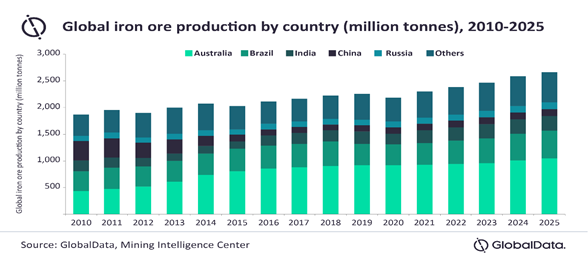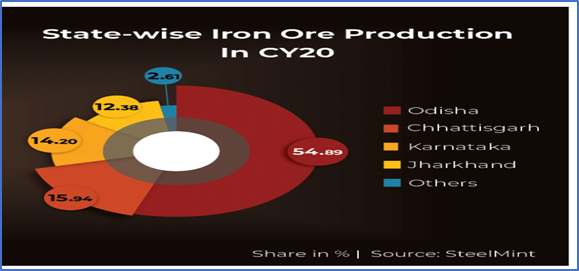In News:
- The Supreme Court has raised the ceiling limit of iron ore mining for Bellary, Chitradurga, and Tumkur districts in Karnataka.
- The court ruled that conservation of the ecology and environment must go hand in hand with the spirit of economic development.
What’s in today’s article:
- Iron ore Statistics
- Iron ore in India (Reserves, Production, Challenges)
- News Summary
Iron Ore statistics:

- Iron ore is the source of primary iron for the world's iron and steel industries.
- Almost all iron ore (98%) is converted into pig iron which is further used for steel making which is then used in construction, transportation, energy infrastructure and household appliances.
- Iron ore is mined in about 50 countries. Australia and Brazil together dominate the world's iron ore exports, each having about one-third of total exports.
- Australia is the leading global producer of iron ore, accounting for 38% of the total production.
Iron Ore Reserves in India:

- With the total resources of over 33.276 billion tonnes of haematite and magnetite, India is amongst the leading producers of iron ore in the world.
- Of the two, haematite is considered to be superior because of its higher grade.
- About 79% haematite ore deposits are found in the Eastern Sector (Assam, Bihar, Chhattisgarh, Jharkhand, Odisha & Uttar Pradesh) while about 93% magnetite ore deposits occur in Southern Sector (Andhra Pradesh, Goa, Karnataka, Kerala, & Tamil Nadu).
- Karnataka alone contributes 72% of magnetite deposit in India
- India is the third-largest producer of iron ore in the world.
Challenges faced by Indian Steel Industry:
- Despite being the third-largest producer of iron ore, India is far behind when it comes to producing and using specialised steel.
- The reasons behind this apparent mismatch are mentioned below:
- Low per capita consumption due to overall poverty –
- Against a world average per capita consumption of 224.5 kgs of steel, India’s was a mere 75 kgs.
- Meanwhile, China’s per capita consumption stands at 590 kgs.
- Shortage of power –
- Steel-making is a power-intensive business, and India is a power-deficit country.
- Costly coal imports from Australia –
- India’s relation to coal vis-à-vis iron ore remains inverse.
- There is much less coal for every tonne of iron-ore mined, which calls for coal imports to keep captive power plants running.
- Australia and Indonesia are two major countries that supply coal to India.
- Of these, Australia has been hiking coal prices which directly affects the price of iron and steel in India.
News Summary:
- The Supreme Court has raised the ceiling limit of iron ore mining for Bellary, Chitradurga, and Tumkur districts in Karnataka.
- The court added that the situation in the state had “vastly changed” since the time a ban was imposed on mining in these districts in 2011.
Background:
- Acting on reports of rampant illegal mining, the Supreme Court had prohibited all mining activity in Bellary, followed by Chitradurga and Tumkur in August, 2011.
- The court directed disposal of the accumulated iron ore through the process of e-auction conducted by the Monitoring Committee and also constituted a Special Purpose Vehicle to take mitigating measures.
- In May 2022, the court after considering petitions, had allowed the “already excavated stock” to be sold directly without resorting to e-auction.
- The petitions said the e-auctions conducted by the Monitoring Committee had received poor response and sale of iron ore even at the reserve price is dismally low.
- Subsequently, the court has also allowed to increase the ceiling limit of iron ore mining in the three districts.









